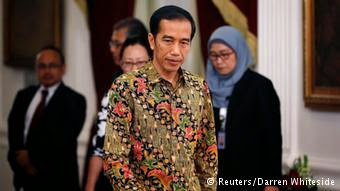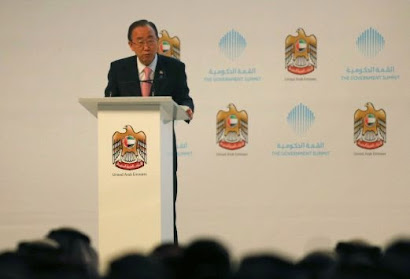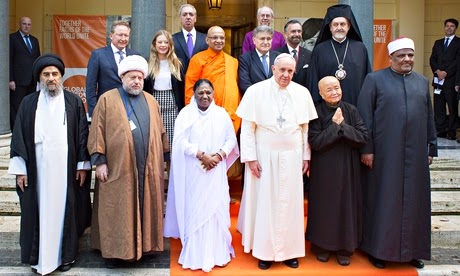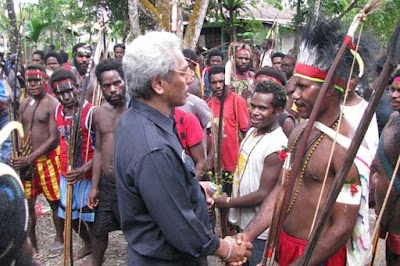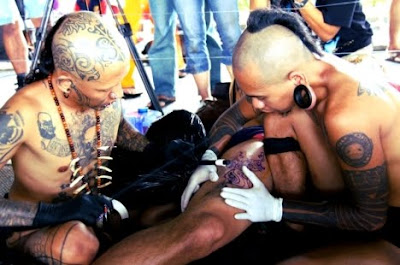
Among Tizar Purbaya’s golek Betawi collection are former President Sukarno, left, President Susilo Bambang Yudhoyono, right, and the kuntilanak witch (above Sukarno). (JG Photos/Ade Mardiyati)
Tizar Purbaya, one of the country’s most celebrated puppeteers, is not the kind of man who separates his home and work lives.
One peek inside his house is proof of both his dedication to and his immersion in his art. The puppet master owns more than 7,000 wayang from across the archipelago, and row upon row of the puppets line every nook and cranny of his two-story home in Sunter, North Jakarta.
In the room where he receives visitors, a dazzling array of puppets is arranged neatly — almost from floor to ceiling — based on characters, origin and the region where they come from. The 60-year-old puppeteer says his passion for wayang was infused in him by the countless number of performances he attended, as well as the regular wayang broadcasts he listened to on the radio, while growing up in West Java
“I was lucky that when I was a kid, there was no TV or outside culture to distract me,” the father of four says. “When watching a performance, I used to sit on the wooden box near the dalang [puppet master] where the puppets were stored, just so that I would be able to help him get the wayang in and out of the box.”
Born to Sundanese and Betawi parents, Tizar was adventurous from an early age.
“I even went to Jakarta to catch a live show [on my own],” Tizar recalls. “I was about 7 years old at the time. I was a free boy. I could go wherever I wanted to and no one would look for me.”
Tizar developed a passion for wayang and nurtured his hunger to learn more about the craft. Not satisfied with just watching the shows and collecting puppets, he craved the experience of being a dalang himself. But it was not until 1974, when he was in his mid-20s, that he got his chance. His first performances were in shows based on classical Sundanese wayang stories.
Four years later, Tizar started a business selling wayang. He produced puppets with his assistants and sold them at Pasar Seni, an art market in Ancol, North Jakarta.
“Pasar Seni was really good back then. A lot of people went there, including tourists from foreign countries,” he says. “Now, it looks like a cemetery. There are only a few kiosks there that are still holding on.”
Ricky Purbaya, Tizar’s 29-year-old son, says that many foreigners who had gone to Pasar Seni before are now disappointed with the state of the market.
“There was this old Dutch couple who said, ‘It was really good when we visited the market when were young,’ ” Ricky recalls.
With the market’s decline, Tizar decided to start selling his wayang from home. Famously, he doesn’t limit himself to producing puppets in the classic style, but also produces customized puppets based on orders from individual clients. Some clients send Tizar photos of themselves and the master then crafts puppets based on the photographs. In his early days of making puppets, many of his clients were foreigners, and Tizar long ago lost track of the number of puppets he has made, but remains modest about his skills.
“People like them. I have made a lot of them up to now,” he says simply.
When he took orders in those early days, Tizar never intended to use custom-made puppets in his performances. It was not until 1998 — when Indonesia was in the grip of financial and political turmoil and many of his foreign clients fled without claiming their made-to-order puppets — that he decided to incorporate these puppets into his shows.
“There were a lot,” Tizar recalls. “I didn’t know what to do with these bule puppets.”
He could not stand to just let the strange-looking, mostly fair-skinned puppets sit to one side, abandoned. “I remembered I had always dreamed about doing something for Jakarta. I wanted it to have its own version of puppets. The Javanese have theirs, the Sundanese theirs. The Betawi didn’t [at that time],” he said.
It did not take long for the idea of creating a puppet style to represent Jakarta natives to take hold, and golek Betawi — “golek” being Sundanese for puppet — was born.
“At the Betawi puppet shows, I perform stories based on the Dutch colonial era and I use the bule puppets I have as Dutch soldiers,” Tizar explains.
Among his puppets fashioned after real people are former US President George HW Bush and his wife, Barbara, which he used in a performance during Bush’s visit to Jakarta in 1994. “We even made a puppet of the president’s dog and it was also included in the five-minute performance,” Ricky says. “The president loved it.”
But Tizar’s favorite creations are the puppets he made during his first few years as a dalang because they can do special things. “My puppets can smoke, eat noodles and vomit,” Tizar laughs.
Inspired by puppets used in Japanese bunraku , that country’s traditional puppet theater, Tizar learned new techniques. He began to master the art of creating puppets that could blink their eyes and move their mouths.
He was so successful that his puppets progressively advanced from the original techniques he found in bunraku. When he performed in Japan, the audience was amazed, he says. “A professor who also makes bunraku puppets was part of the audience,” Tizar says. “He asked me a lot of questions, such as how could the puppet’s nose grow longer, or how they could puff on cigarettes.”
Tizar’s golek Betawi have become such a hit that he has been invited to perform all over Indonesia and abroad. One secret, Tizar says, is that he often tells stories built on current events.
“As long as you know the basics of the story, with all the characters, you can change the setting to today,” he says.
As long as the essence of the legend is intact, anything can be incorporated. “Take, for example, when [Islamic group] Muhammadiyah asked me to perform. I used a story about raids over so-called wrongdoings, you know like the ones [by hard-line Muslim group] FPI, but the main character was Si Jampang [a legendary Betawi character said to have lived during the colonial era].”
Does he touch on today’s really hot issues, such as the Corruption Eradication Commission’s problems or the Bank Century bailout? No, Tizar says, but he has been asked to. “How can I tell a story whose truth is still unknown? Like Antasari [Azhar], we still don’t know whether he is involved or not. I don’t want to judge in my stories,” he says, referring to the former head of the anticorruption body. “One thing for sure is that I don’t want to become famous on [the back of] people’s sorrows.”
The only thing Tizar wants now is to see new Betawi puppeteers follow in his footsteps. The only person he sees as able to fulfill his wish at the moment is his son Ricky. “I did not create this for myself, this is for everyone,” he says.
Tizar says he would like to see the Jakarta administration set up a school where anyone can learn golek Betawi. “It’s too bad they haven’t thought about things like that,” he says. “It would be hard for me to do it myself. First, I’m too old to build a school. Then it wouldn’t be easy to secure a location for it and get the funding. I’m tired.”
Tizar also has harsh words for Jakarta Governor Fauzi Bowo, whom he says did not fulfill his promise to help preserve his art. In an encounter with the governor a month before the city’s anniversary last year, Tizar says Fauzi promised him some stages that he could use to perform on during the celebrations. “I remember he said: ‘I’ll have my people contact you’ when I gave him my business card, but nothing happened,” Tizar says.
“When I met him again on a different occasion, he asked about that and I told him what happened and he made another promise, but it was the same. Nothing happened. It was just lip service.”
Tizar says that the failure to preserve the country’s traditional arts can lead to problems, such as the claims other countries have made to Indonesia’s heritage. “And when it happens,” Tizar says, “people can only cry out loud.”
